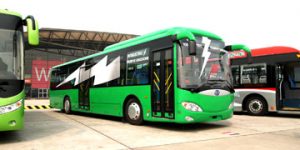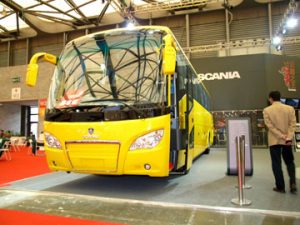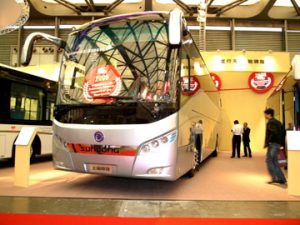By Doug Jack
I am probably stretching the point to send this Letter from Europe from the Busworld Asia exhibition in Shanghai, China held in April. Nonetheless we all need to be aware of developments by Chinese bus and coach manufacturers.
The number of vehicle exhibitors was down slightly from previous years. Three of the largest manufacturers, King Long, Zhengzhou Yutong and Golden Dragon did not attend. That was probably due to a rival bus exhibition in Beijing three weeks later, or because the companies had nothing new to show. With so many other new vehicles no one really missed them.
The Chinese manufacturing industry has made tremendous strides in recent years. This was noticeable on the streets of Shanghai, where Sunwin Bus, a joint venture between the local Shanghai Automotive Industry Corporation and Volvo Bus Corporation supplied 13,000 out of the 15,000 buses in service.
Until recently some Chinese manufacturers were notorious for copying Western European, Japanese and Korean designs. Now tighter laws protect intellectual property rights. Neoplan successfully sued Zonda for copying the second-generation Starliner coach and won an injunction that prohibits the Chinese company from continuing to build its copy. There was plenty of evidence to show Chinese manufacturers are capable of developing their own designs that are stylish and free from flashy ornamentation.
While the majority of vehicle manufacturing aims at lower price points, those intended for the upper market segments appear well built. Several factories have invested in large tanks that fully immerse vehicle structures in chemicals that protect against corrosion, and in ovens that bake the chemicals onto steel frames. Other manufacturers are using galvanized steel.
With the economy growing by around 12 percent and large-scale construction of new roads, railways and skyscrapers, Shanghai is gearing up for a World Expo next year on large semi-circular sites on either side of the Huangpo River. The organizers of the World Expo in Shanghai decided they will require 120 all-electric buses to operate within the site and a further 150 hybrid buses for peripheral services, which has created a rush to develop new designs.
Each year preceding Busworld Asia, Asian Coach Week features awards for new designs in various vehicle categories. Sunwin Bus offered both a pure electric bus and a hybrid. Chinese city buses tend to have wheelbases similar to ours in Europe, therefore large banks of lithium iron phosphate batteries where located behind the rear axle beneath the seats.
On the test track the 40-ft pure electric bus reached 30 mph in 20 seconds — actually faster than necessary for a city bus carrying standing passengers, but completely jerk-free. The loudest noise came from the power steering pump as we turned corners.
Small numbers of all-electric buses run in Europe, but none longer than 25-ft with limited range. This full-size all-electric bus suggests the Chinese have a significant technical lead.
Sunwin says the pure electric bus can travel for more than 100 miles on fully charged batteries, an equivalent to six or seven hours in city traffic. A complete recharge takes three hours, but as an alternative, a fully recharged battery pack can easily replace a depleted battery pack within ten minutes. One spare pack should keep two pure electric buses in services all day.
This technology comes with a price. A standard low-entry Sunwin city bus with Volvo running units costs around $130,000. The price of the pure electric bus is nearly twice that amount and a spare battery pack costs around $120,000. China is investing heavily in nuclear energy and says that lower price of electricity, compared with diesel, will compensate for the higher initial price over the lifetime of the vehicle.
Sunwin’s 37-ft hybrid bus features a low floor from the front entrance to the center exit. A Cummins ISBe 220 diesel engine drives a generator that feeds a 60kW electric motor. Again, lithium iron phosphate batteries store the energy.
On the test track the bus accelerated smoothly up to 15 mph using only electric power before the diesel engine took over through a Chinese Eaton AMT automatic gearbox until the bus decelerated.
Bus and Coach International (BCI), Perth, Australia, owns 60 percent of the Jiangxi Bonluck Business Bus Co. With the demand for buses and coaches in Australia over the last two years rising well above the capacity of local bodybuilders, BCI was able to register 151 new units in 2008 due to free trade agreement between United States and Australia, with U.S. products such as Cummins engines treated as Australian. The Bonluck factory also uses Australian steel.
The busy BCI stand showed a low-entry hybrid and all-electric full-size city buses, as well as a 27-ft midi coach with an all-electric drive system. The standard diesel version of this vehicle has proved popular in Australia. The all-electric model fitted with a wheelchair lift ahead of the rear axle had 672 Hitachi batteries mounted under the floor taking up the normal luggage area. This coach has a range of 60 to 90 miles on a full charge, depending on the application.
The Hunan CSR Times Electric Vehicle Co., a joint venture in Zhozhou between an electric locomotive research institute, the Tsinghua University and the Sany Group, is developing a number of joint products, including what it claims to be the first parallel hybrid low-entry city bus in China. The company may offer models from 33-ft to 40-ft with diesel engines that develop 160 to 220 bhp. It is unusual to see so many city buses in China still using a traditional stick shift, and very surprising to find a five-speed manual gearbox on such a modern concept vehicle.
While some European manufacturers charged into China a few years ago and had unhappy experiences with local partners, Scania of Sweden has taken a more cautious approach that now appears to be taking off. Scania has teamed up with one of the largest builders, Higer, to offer coaches in the premium sector. While much of China is running one or two stages behind Europe in Euro emission standards, Hong Kong has introduced emission limits concurrently with Europe.
Scania and Higer have jointly supplied coaches with EGR engines for use on the busy cross-border services to mainland China.
The two companies also have launched the first double-deck coach built by Higer. Though it looks impressive, Asian Coach Week judges were critical of three features, particularly the staircase. But give the Chinese engineers credit. They listened carefully, took copious notes and were not the least offended at the comments for improvement. In fact they have probably already incorporated the suggestions.
Although the Chinese Government encourages consolidation to create fewer companies with high volume manufacturing and economy of scale, newcomers are still appearing. The Shanghai Shenlong Bus Co, created in 2004 and trades as Sunlong, built more than 3,000 buses and coaches last year and won several prizes during Asian Coach Week. Most unusual for China, Sunlong exhibited a city bus using the Swiss Alcan aluminum structural system.
The Chinese are stepping up their efforts in export markets with an increasing number of manufacturers being willing to build to North American, European and Russian regulations. Many visitors came from other parts of the world to look at potential Chinese suppliers. Temsa Global, the Turkish-based manufacturer has gone one step further, establishing an office in Shanghai to source components for its factories in Turkey and Egypt. Temsa president Mehmet Buldurgan says the company is now active in 44 markets including the United States.
Doug Jack is with Transport Resources in the United Kingdom.



